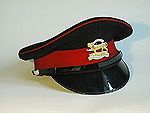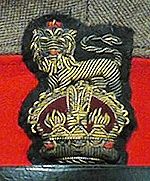|
|
|
A brief guide to modern British parade headgear
Literally thousands of books have been written about British uniforms, cap badges,
unit traditions, etc. In fact, the sheer quantity of information available sometimes makes
finding out about a particular cap something akin to looking for a needle in a haystack.
At any rate, here are the "general rules" I’ve discovered up until now.
Please feel free to contact me if you have anything to add.
Visors
Badges
Side buttons
Chinstraps
Dress codes
Cap colors
Special regimental
headgear
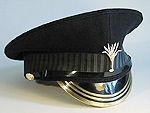 Typical NCOs cap from the Welsh Guard, featuring peakmount, rank stripes, and an altered visor angle. |
Visors
Enlisted men generally have plain visors without any embellishments. However,
Guards regiments (Irish, Welsh, Scots, Coldstream, Grenadier—the infantry element of
the so-called Household Troops) usually feature brass visor trim on the edge (peakmount).
NCOs, particularly in the Guards regiments, have a tradition of altering the angle of the visor so that it points downwards, practically touching the forehead. Moreover, some senior NCOs have visor decorations on the shiny visor consisting of one or more concentric lines in gold or brass running parallel to the brim.
Warrant officers usually have caps that are similar in shape and style to officer’s caps, though with shiny visors.
Dress caps for all field-grade Army officers feature visor decorations consisting of a 3/4 inch wide gold bullion "stripe." However, please note than in some regiments, ALL officers are allowed to wear this stripe—even lowly second lieutenants! Field officers in Light Infantry regiments have a silver stripe and field officers in Rifle regiments have a single row of black oak leaves. Substantive (full) Colonels and Brigadiers wear one row of gold oak leaves and Generals and Field Marshals wear two rows.
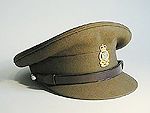 Standard khaki officer's cap |
Khaki caps only have visor decorations for very senior personnel—if at all. Officer’s caps have khaki cloth-covered visors.
Royal Navy officers have plain, leather visors up to the rank of Commander, a single row of oak leaves up to the rank of Commodore, and two rows of oak leaves for Admirals.
RAF officers have plain, cloth-covered visors up to the rank of Wing Commander, a single row of oak leaves for ranks up to Air Commodore, and two rows of oak leaves for Air Marshals. Enlisted men and NCOs have plain, shiny visors.
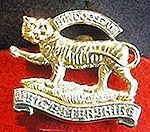 Typical Staybrite badge for enlisted men.
|
Badges
RAF and Royal Navy officers and NCOs have bullion badges, as do Substantive
Colonels, Brigadiers and Generals in the Army. All others have metal badges. There are
occasionally differences in the metal badges for officers and enlisted men. For example,
officers in the military police have silver badges, whereas WOs, NCOs and EM have gilt
badges. Also, army officers sometimes have a piece of colored felt behind the metal badge.
In all cases, it’s probably best to refer to a specialist book.
In the Army, Substantive Colonels and Brigadiers wear badges that consist of a lion perched atop a crown. Higher ranks retain the lion and crown, but this, in turn is mounted on top of the Royal Crest, which encloses a crossed sword and a baton. Field Marshals have two crossed batons in the center of the crest.
Bullion RAF badges for higher ranks are similar to the Army badges, but also include a pair of wings. All officers and warrant officers also have bullion badges, but somewhat less grand in style. Enlisted men have metal badges that read "RAF."
Side buttons
Side buttons and cap badges are almost always related in some way. For example, the
Royal Leicestershire regiment features a tiger, on both the badge and buttons. Most other
regiments also have special regimental side buttons. The side buttons for the Royal Navy
and Royal Air Force, however, are not related to a specific regiment. Officers will
usually have black, cloth-covered buttons, and enlisted men will have black plastic
buttons. Gold buttons being reserved for RAF generals and RN admirals.
Side buttons for Substantive Colonels and higher Army ranks will often feature the cipher of the reigning monarch rather than a regimental pattern, too.
 Typical enlisted man's vinyl chinstrap with buckle.  Typical leather officer's chinstrap. |
Chinstraps
Chinstraps for enlisted men and NCOs are made of thin leather or plastic and
feature two adjustable buckles. Warrant officers and officers, on the other hand, have
slightly wider chinstraps in leather equipped with leather sliders.
The exception to the rule is the Royal Navy, which retains the buckle arrangement for all ranks.
Dress codes
Before getting down to actual color combinations for the many different hats
currently in use, it’s important to keep in mind that there are about 15 different
individual dress codes in the British Army, each designed for a specific function, season,
or climate. Here’s a brief rundown:
Full dress: traditional ceremonial
dress—very formal, like for the changing of the guard at Buckingham palace.
No. 1 dress: slightly less formal dress, generally referred to as
"blues" and introduced in the early 50s to replace full dress for all but the
most formal occasions.
No. 2 dress: the standard khaki parade uniform worn since 1960.
This has, to a great extent, replaced the unpopular No. 1 dress for ceremonial occasions.
No. 3 dress: white cotton version of No. 1 dress for warm weather
No. 4 dress: officer’s service dress for warm weather.
No. 5 dress: no longer exists
No. 6 dress: bush jacket pattern warm weather parade uniform
No. 7 dress: warm weather barrack dress
No. 8 dress: temperate battle dress
No. 9 dress: tropical battle dress
No. 10 dress: temporate mess dress
No. 11 dress: warm weather mess dress
No. 12 dress: protective clothing
No. 13 dress: temperate barrack dress
No. 14 dress: shirt sleeves
By the way, temperate areas include the UK and Northern Europe. Warm weather areas include the Carribbean, Canada, the U.S., the Mediterranean, Nepal, Brunei, and until recently, Hong Kong.
For the most part, the headgear worn for No. 1 dress is also used for No. 3, 10, and 11 on all occasions and No. 2 and 6 for formal occasions. Moreover, the khaki peaked cap may also be worn by officers and WO1s at any time, except when No. 1, 3, 10, or 11 dress is required, for example, with No. 4 dress.
Cap colors
By and large, most No. 1 headgear consists of a dark blue peaked cap with a red
band and piping. That said, many of the older regiments use other color
combinations—or even different cap styles. I apologize for some of the
acronyms—I haven’t figured them out yet.
Blue crown, scarlet band, scarlet piping:
Blues and Royals
DERR
Life Guards
Grenadier Guards
King’s
King’s Own Royal Border
Queen’s Lancashire
Queen’s Royal Regiment of Fusiliers
Royal Anglians
Royal Army Ordnance Corps
Royal Artillery
Royal Electrical and Mechanical Engineers
Royal Hampshire
Royal Military Acadamy Sandhurst
Royal Military School of Music
Royal Pioneers
Royal Regiment of Wales
Royal Welch Fusiliers
Small Arms School Corps
Blue crown, scarlet/white/blue diced band, scarlet
piping:
Scots Guards
Blue crown, dull cherry band, dull cherry piping:
Royal Army Medical Corps
Blue crown, blue band, blue piping:
1st Queen’s Royal Dragoon Guards
Royal Signals
Blue crown, royal-blue band, royal-blue piping:
The 4th/7th Royal Dragoon Guards
Blue crown, blue band, scarlet piping:
Army Physical Training Corps
Devon and Dorset
Duke of Wellington’s
Glostershire Regiment
Green Howards
Military Provost Staff Corps
Prince of Wale’s Own Yorkshire
Royal Engineers
WFR
Blue crown, blue band, primrose-yellow piping:
Royal Army Pay Corps
Blue crown, blue band, white piping:
Royal Corps of Transport
Blue crown, yellow band, blue piping:
Royal Scots Dragoon Guards
Blue crown, black band (with vertical stripes),
blue piping:
Welsh Guards
Blue crown, white band, white piping:
Coldstream Guards
Blue crown, green band, green piping:
Irish Guards
Blue crown, maroon band, maroon piping:
Royal Army Veterinary Corps
Blue crown, emerald green band, emerald-green
piping:
Royal Army Dental Corps
Blue crown, green band, green piping:
Intelligence Corps
Blue crown, gray band, gray piping:
Army Catering Corps
Blue crown, purple band, purple piping:
Clergymen (Bishops, etc.)
Red crown, red band, red piping:
Queen’s Royal Irish Hussars
14th/20th King’s Hussars
Crimson crown, crimson band, crimson piping:
Royal Hussars
Scarlet crown, scarlet band, scarlet piping:
Queen’s Own Hussars
15th/19th King’s Royal Hussars
Scarlet crown, scarlet band, blue piping:
9th/12th Royal Lancers
Scarlet crown, blue band, blue piping:
17th/21st Lancers
Scarlet crown, blue band, scarlet piping:
Royal Military Police
Green crown, primrose band, primrose piping:
5th Royal Inniskilling Dragoon Guards
Rifle-green crown, rifle-green band, rifle-green
piping:
Light Infantry
Rifle-green crown, rifle-green band, black piping:
Royal Greenjackets.
White crown, blue band, no piping:
13th/18th Royal Hussars
White crown, red band, white piping:
Royal Marines
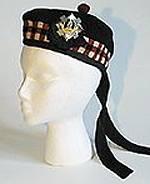 A Royal Scots glengarry |
Special
regimental headgear
The traditional headdresses of the British Army—glengarries and
balmorals—also feature unique color combinations, depending on the regiment involved.
In some cases, pipers will wear glengarries, even if the parade headdress for the rest of
the regiment is different. Moreover, blackcock or eagle feathers are added behind the
badge for some regiments and/or pipers. Here are of some of the various types:
Queen’s Own Highlanders
Blue glengarry, scarlet toorie (pompom), and blue hackle. No diced band.
Pipers wear eagle feathers behind badge.
Gordon Highlanders
Scots Guards (pipers)
Blue glengarry, scarlet/blue/white diced band, scarlet toorie.
SG pipers wear blackcock feathers behind badge.
Argyll & Sutherland Highlanders
Blue glengarry, scarlet/white diced band, scarlet toorie.
Royal Scots
Royal Highland Fusiliers
King’s Own Scottish Borderers
Blue glengarry, scarlet/green/white diced band, scarlet toorie.
RS and KOSB wear blackcock feathers behind badge.
Cameronians
Green glengarry, black toorie, no diced band.
London Scottish
Blue glengarry, royal blue toorie, no diced band.
King’s Own Scottish Borderers
Blue balmoral, scarlet toorie, scarlet hackle.
